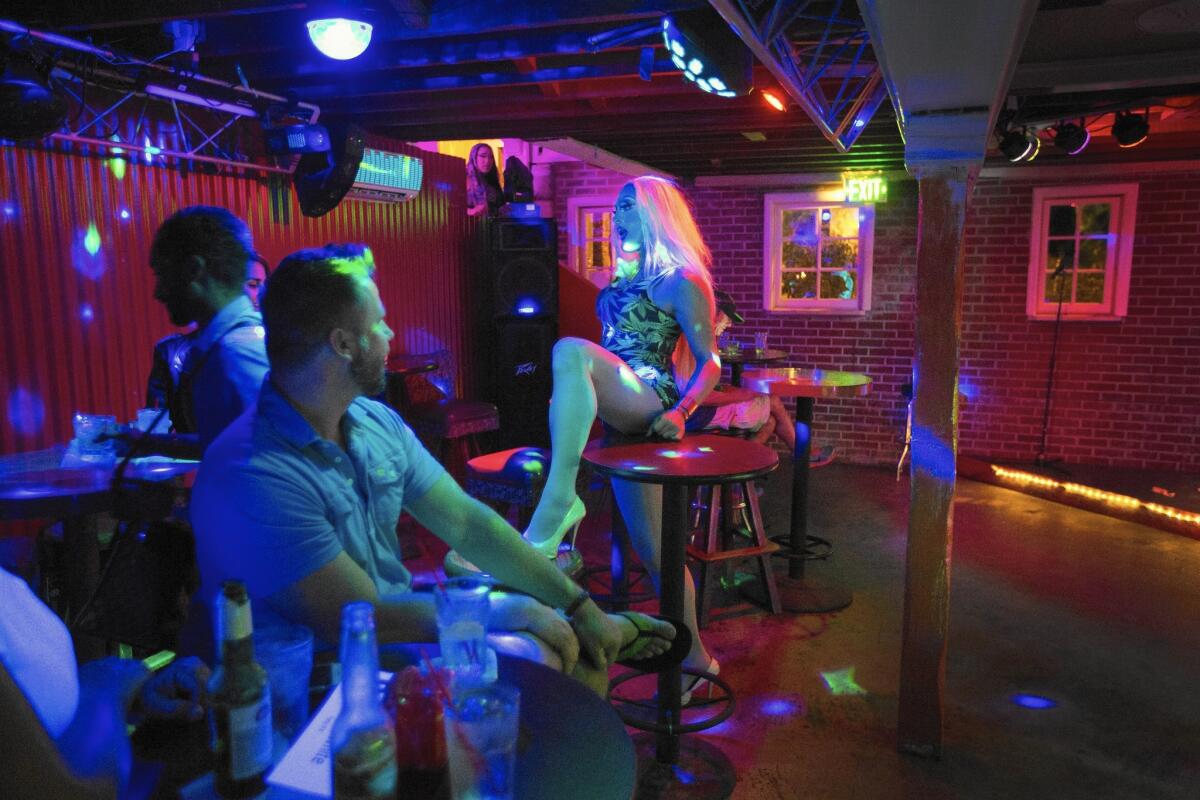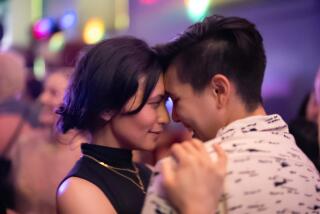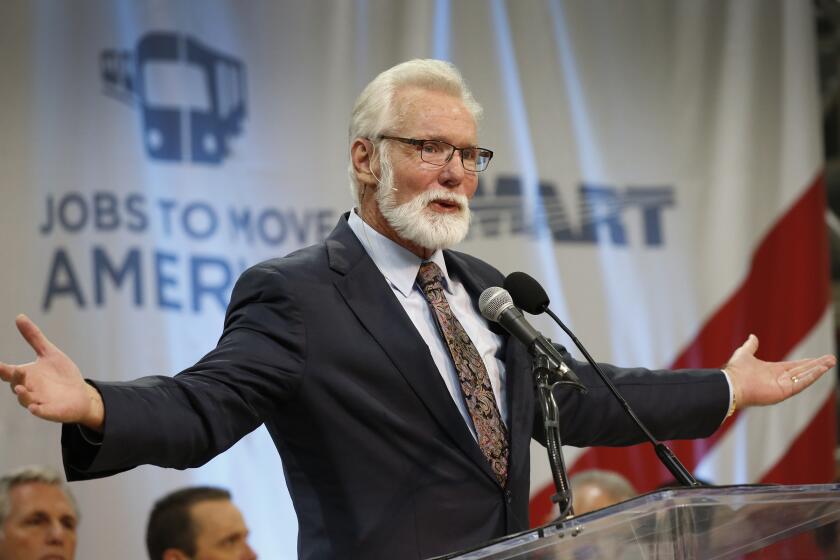Are ‘gayborhoods’ a victim of the gay rights movement’s success?

- Share via
Reporting from Laguna Beach — For decades, the blinds of this semisubterranean Laguna Beach bar were closed tight.
Back then, the dingy saloon was underground in more ways than one.
People whom employers might still refuse to hire because of their love interests flirted openly as they knocked back martinis. Couples whom hotels might turn away for wanting to share a room danced and kissed without anxiety.
To step down the stairwell into the bar, patrons of that era say, was to find sanctuary from streets where, even in the 1980s — even in this then-funky liberal enclave — gay bashing often took a literal turn. In one particularly ugly incident in Laguna, an Orange County resident lost six teeth and the sight in his left eye after young men attacked him with pipelike objects, yelling: “Faggots! I’m gonna kill you.”
And, so, the shutters. “They were closed,” the bar’s current manager recalls. “Always closed.”
Over the years, as homosexuals fought for and won one victory after another in pursuit of equal rights, Laguna blossomed into one of California’s most famously gay-friendly communities. Bars and other businesses catering to people across the spectrum of sexual orientation popped up all over the little beach town.
Now, with overt discrimination and Laguna’s homosexual population both waning, Main Street Bar and Cabaret is the last gay-specific establishment in town — and the place where Orange County Gay Pride Week is scheduled to hold its wrap-up party on Sunday.
But expressing pride these days also means recognizing a paradox: Many gay enclaves that weathered, first, anti-gay discrimination and then the devastation of the HIV-AIDS epidemic are quickly becoming victims of the gay rights movement’s success.
Laguna Beach had flourished as a gay-friendly haven before such communities were common. The county’s first openly gay politician, Bob Gentry, became the city’s mayor and championed legislation to protect gays from discrimination.
A 1984 New York Times story reported: “This quiet seaside resort, known for decades as an arts colony, has emerged as a focal point for homosexual politics in predominantly conservative Orange County.”
Then HIV and AIDS began to ravage the country and the beach town. Laguna had one of the highest per capita death rates in the nation.
Over time, economics would also drive an exodus.
Property values in neighborhoods with high concentrations of gay and lesbian residents rise more quickly compared with the national average, according to the real estate site Trulia.
Census data from 2000 and 2010 show, however, that many “gayborhoods” are becoming less so as residents are priced out or “evolve out” — a term for what happens when gay and lesbian couples feel more comfortable living and socializing in a broader range of areas, says Amin Ghaziani, an associate professor of sociology at the University of British Columbia who has written extensively on the topic.
Laguna Beach eventually lost its critical mass of gay residents to places such as Palm Springs and the surrounding Coachella Valley, which became known as relatively affordable, safe and gay-friendly.
In response to the change, more cities are making efforts to put a clear stamp on their gay neighborhoods to ensure their visibility, Ghaziani says.
“Change is inevitable,” he says, “but demise is not.”
The last lesbian bar in West Hollywood has closed, but last year people there protested when, in what was touted as an embrace of diversity, the City Council removed the rainbow flag from above City Hall. (The council later agreed to put up a new flag with a rainbow city logo.)
In San Francisco’s Castro neighborhood, a GLBT history museum, rainbow crosswalks and the Rainbow Honor Walk commemorate the area’s declining gay population, said Supervisor Scott Wiener, who lives in and represents the neighborhood.
“We all want these communities to stay intact,” Wiener said. “There are also limits to what we can do.”
Some in Laguna Beach are determined to do their part.
One group of residents is working to revive the historically gay gatherings at West Street Beach.
Frankie Ciccone, 36, started a Facebook page for the locale several years ago. He regularly posts playful photos of chiseled men in Speedos — images that aren’t unlike photos taken in the 1970s, now stored in an archive at UC Irvine, of seemingly endless throngs of smiling male beachgoers.
“The gay community needs a place to go,” Ciccone says.
Across Pacific Coast Highway at the Main Street Bar and Cabaret, manager Craig Cooley, 63, talks about ushering in “gay culture 2.0.”
“It’s our turn to give back and welcome straight people into our world,” Cooley says. “I want to feel that this is a component — this little bar is a component — in what Laguna has to offer.”
As a recent Wednesday night drag show kicked off at Main Street, a crowd of about 15 — gay and straight, male and female — clustered at tall tables. The lyrics to “Commander” boomed through the speakers, as the evening’s host, Mae Loda-Bride — “mail order bride” — strutted out in lace-up stiletto boots.
She encouraged them to tip (drag queens can’t afford to live in Laguna, she quipped), then introduced, one by one, four drag queens.
Now and then passersby heard the music and peered through the unshuttered windows. “Hi, do you want to come in?” Loda-Bride beckoned.
Gentry, the former mayor, left the beach town in 1999 and now resides in Honolulu and the Coachella Valley. With a touch of melancholy, he says that Laguna today is “very different.”
“Communities change — I understand that,” he says. “The sad part for me, personally, as a gay man who ... loved and still loves that city desperately ... [is that] there weren’t many people standing up to say, ‘We need to do something about this dynamic change.’
“I think there was also a subtle feeling in part of the city of taking a deep breath and saying, ‘Ah, thank goodness, we’re back to normal,’” he says.
Kevin O’Grady, the executive director of LGBT Center OC, says that Laguna’s drift back toward more standard demographics weakens the wider gay community. “I think it ... increases or exaggerates a sense of isolation,” he says.
Few gay activists doubt that Orange County attitudes have changed. Santa Ana’s City Council, for example, is expected to vote soon on whether to fly a pride flag from City Hall. And two of the plaintiffs in the U.S. Supreme Court’s recent history-making same-sex marriage case now live in Placentia.
Yet it’s also telling that on the June day the court legalized same sex marriage, while San Francisco and other cities erupted into raucous street parties, one of the few public signs of celebration in Laguna Beach took place outside the Main Street Bar and Cabaret, where 33-year-old bartender Jay Corona stationed himself on the sidewalk for hours, dutifully waving a gay pride flag.
MORE LGBT COVERAGE:
Decision on gay Scout leaders settles the issue — or not
In West Hollywood, gay couples from China fulfill a dream: marriage
Same-sex marriage ruling creates new constitutional liberty
More to Read
Sign up for Essential California
The most important California stories and recommendations in your inbox every morning.
You may occasionally receive promotional content from the Los Angeles Times.










